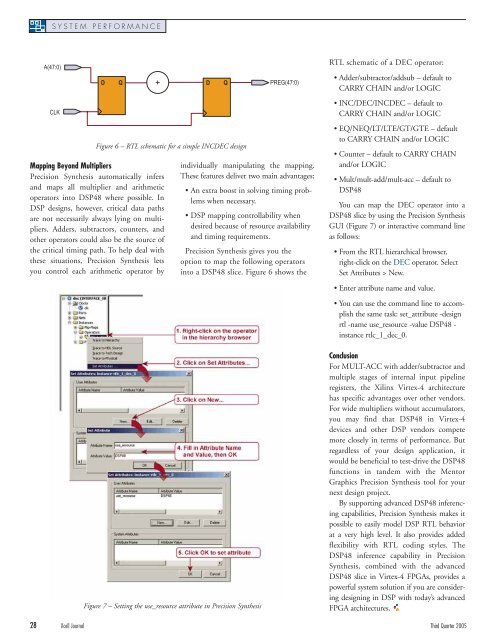Design Challenges: Avoiding the Pitfalls, winning the game - Xilinx
Design Challenges: Avoiding the Pitfalls, winning the game - Xilinx
Design Challenges: Avoiding the Pitfalls, winning the game - Xilinx
Create successful ePaper yourself
Turn your PDF publications into a flip-book with our unique Google optimized e-Paper software.
SYSTEM PERFORMANCE<br />
A(47:0)<br />
CLK<br />
Mapping Beyond Multipliers<br />
Precision Syn<strong>the</strong>sis automatically infers<br />
and maps all multiplier and arithmetic<br />
operators into DSP48 where possible. In<br />
DSP designs, however, critical data paths<br />
are not necessarily always lying on multipliers.<br />
Adders, subtractors, counters, and<br />
o<strong>the</strong>r operators could also be <strong>the</strong> source of<br />
<strong>the</strong> critical timing path. To help deal with<br />
<strong>the</strong>se situations, Precision Syn<strong>the</strong>sis lets<br />
you control each arithmetic operator by<br />
D<br />
Q<br />
+ D Q<br />
Figure 6 – RTL schematic for a simple INCDEC design<br />
individually manipulating <strong>the</strong> mapping.<br />
These features deliver two main advantages:<br />
• An extra boost in solving timing problems<br />
when necessary.<br />
• DSP mapping controllability when<br />
desired because of resource availability<br />
and timing requirements.<br />
Precision Syn<strong>the</strong>sis gives you <strong>the</strong><br />
option to map <strong>the</strong> following operators<br />
into a DSP48 slice. Figure 6 shows <strong>the</strong><br />
Figure 7 – Setting <strong>the</strong> use_resource attribute in Precision Syn<strong>the</strong>sis<br />
PREG(47:0)<br />
RTL schematic of a DEC operator:<br />
• Adder/subtractor/addsub – default to<br />
CARRY CHAIN and/or LOGIC<br />
• INC/DEC/INCDEC – default to<br />
CARRY CHAIN and/or LOGIC<br />
• EQ/NEQ/LT/LTE/GT/GTE – default<br />
to CARRY CHAIN and/or LOGIC<br />
• Counter – default to CARRY CHAIN<br />
and/or LOGIC<br />
• Mult/mult-add/mult-acc – default to<br />
DSP48<br />
You can map <strong>the</strong> DEC operator into a<br />
DSP48 slice by using <strong>the</strong> Precision Syn<strong>the</strong>sis<br />
GUI (Figure 7) or interactive command line<br />
as follows:<br />
• From <strong>the</strong> RTL hierarchical browser,<br />
right-click on <strong>the</strong> DEC operator. Select<br />
Set Attributes > New.<br />
• Enter attribute name and value.<br />
• You can use <strong>the</strong> command line to accomplish<br />
<strong>the</strong> same task: set_attribute -design<br />
rtl -name use_resource -value DSP48 -<br />
instance rtlc_1_dec_0.<br />
Conclusion<br />
For MULT-ACC with adder/subtractor and<br />
multiple stages of internal input pipeline<br />
registers, <strong>the</strong> <strong>Xilinx</strong> Virtex-4 architecture<br />
has specific advantages over o<strong>the</strong>r vendors.<br />
For wide multipliers without accumulators,<br />
you may find that DSP48 in Virtex-4<br />
devices and o<strong>the</strong>r DSP vendors compete<br />
more closely in terms of performance. But<br />
regardless of your design application, it<br />
would be beneficial to test-drive <strong>the</strong> DSP48<br />
functions in tandem with <strong>the</strong> Mentor<br />
Graphics Precision Syn<strong>the</strong>sis tool for your<br />
next design project.<br />
By supporting advanced DSP48 inferencing<br />
capabilities, Precision Syn<strong>the</strong>sis makes it<br />
possible to easily model DSP RTL behavior<br />
at a very high level. It also provides added<br />
flexibility with RTL coding styles. The<br />
DSP48 inference capability in Precision<br />
Syn<strong>the</strong>sis, combined with <strong>the</strong> advanced<br />
DSP48 slice in Virtex-4 FPGAs, provides a<br />
powerful system solution if you are considering<br />
designing in DSP with today’s advanced<br />
FPGA architectures.<br />
28 Xcell Journal Third Quarter 2005

















